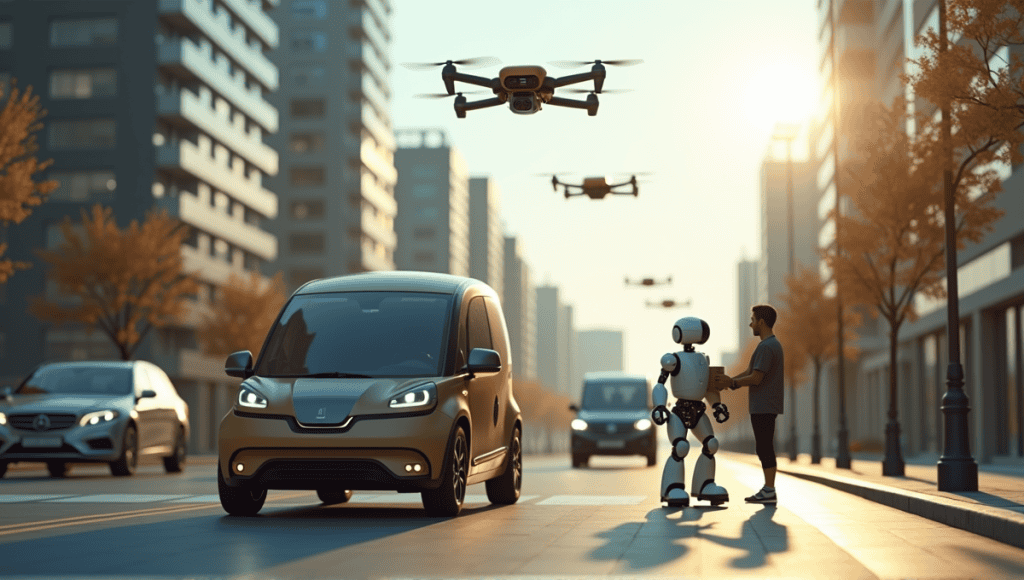Last mile automation reduces delivery costs by 40%. I’ve witnessed this as an engineer who focuses on condition monitoring, so I understand the power of optimizing processes. If you’re anything like me, you want to know if it’s a good investment. Let’s run through the numbers and discuss how this technology is transforming the delivery industry.
End-Stage Delivery Optimization Systems

Last mile automation is transforming the delivery industry, and I’ve personally witnessed its impact in my job as a condition monitoring expert. These technologies are game changers for logistics companies. Last-mile logistics plays a crucial role in the overall efficiency of the supply chain.
Autonomous delivery vehicles are the main automation tool. They drive through city streets without human drivers, making deliveries at scale. Delivery robots and drones work in conjunction with these vehicles for smaller items or harder to reach locations.
Smart lockers and pick-up points are located all over the place. These allow customers to access their package at any time of day in a safe location. This is a huge benefit for busy city inhabitants.
AI route optimization software is the secret sauce to making deliveries in the most efficient manner. These algorithms process massive amounts of data to determine the fastest, most cost effective route. I’ve seen the power of these algorithms through my work in industrial automation.
Automated sorting and packaging systems streamline how packages move through distribution centers. They guarantee packages are properly sorted and packaged for their final destination.
The data doesn’t lie. Autonomous delivery can reduce costs by 40%, and AI route optimization can reduce delivery times by 20-25%. These aren’t marginal improvements – they’re complete reinventions of the process.
Advantages of Final Delivery Optimization
Last mile automation is a win-win for businesses and customers, and the benefits are primarily:
Lower operational costs:
- Less labor
- Less fuel
- Fewer human error costs
Faster deliveries and improved efficiency are obvious benefits. Automation doesn’t take breaks and can work around the clock optimizing each step of the process.
Higher customer satisfaction is a natural byproduct. If you can offer faster, more reliable deliveries, customers will be happier. I’ve witnessed this in nearly every industry.
More accurate deliveries result in fewer mistakes and fewer returns. Automation won’t forget to deliver something or take it to the wrong address.
Few people consider the environmental benefits. Optimized routes and electric vehicles significantly reduce carbon emissions.
Don’t overlook the financial impact. Last mile delivery represents 41% of total supply chain costs. Even more mind-blowing, 53% of total shipping costs can be attributed back to last mile delivery. It’s clear automation is critical in this space.
Implementing Last Mile Automation Solutions
Implementing last mile automation is a strategic process. I’ve helped many companies navigate similar technological transitions.
Start by evaluating your current last mile operations. Where are the bottlenecks, inefficiencies, and areas of opportunity? This is essential to selecting the right solutions. Supply chain analysis can provide valuable insights into these areas.
Next, choose the automation technologies that best meet your needs, fit your budget, and align with your long-term goals. Don’t just select the newest tech on the market to select it.
Integrating with existing logistics systems is usually the hardest part. It requires careful planning and execution to ensure the new system is compatible and seamlessly communicates data with the existing system.
Properly training employees and managing change is essential. You need your team to know how to use this technology and be bought into the idea. If your team members don’t embrace the change, it won’t be successful, regardless of how great the automation technology is.
Don’t forget about pilot testing. Start with a small implementation, refine your approach, and then scale. This makes it easy to work out the kinks before diving into a full implementation.
Lastly, remember that the implementation of last mile automation is a journey, not a destination. You should always be looking for ways to improve.
Challenges in Last Mile Automation Adoption

Of course, adopting last mile automation isn’t without its challenges. I’ve personally encountered many of these challenges in my consulting work.
Primarily, high initial investment costs scare away most companies. The capital expense to purchase autonomous vehicles robots, and AI pales in comparison to the operational savings realized down the line.
There are also still technological limitations and reliability concerns to consider. For example, autonomous vehicles still struggle to operate in certain weather conditions or navigate complex urban environments. Delivery robots can’t yet cross certain obstacles, such as stairs, or enter secured buildings.
Regulatory and legal considerations also differ depending on the specific region. Drones, for instance, face strict airspace regulations. Autonomous vehicles must comply with a variety of regional and national laws.
Public acceptance and safety are the most significant challenges of all. People are naturally still afraid of driverless cars, drones, and so on. Thus, building essential trust takes time and transparent messaging regarding the safety of your solution.
Data security and privacy are also massive concerns. After all, you’re collecting tons of data, often completely automatically. Thus, protecting this data from a breach and using it responsibly are also paramount.
The good news is that none of these challenges are impossible to solve. Instead, it just takes thoughtful planning, ongoing iteration, and a strong commitment to addressing public concerns.
Automating Final Delivery Processes to Enhance Customer Satisfaction
Last mile automation has a major impact on the customer experience. It’s also defining customer expectations for delivery services.
Real-time tracking and delivery updates:
- GPS vehicle tracking
- Automated SMS or app notifications
- Accurate delivery time window information
Customers demand shipping control through delivery options and time windows. This allows them to choose a time they know they’ll be home to receive it, reducing missed deliveries.
Contactless delivery options are a customer favorite. It’s more convenient and addresses health concerns.
Customers expect a personalized delivery experience. AI will learn a customer’s preferences and optimize delivery services.
Customer feedback loops allow for continuous optimization. Automation allows the system to iterate based on customer feedback.
The data is clear on what matters most to customers. 93% of customers want delivery status updates. 47% of customers won’t reorder due to poor delivery visibility. And 98% of customers say shipping impacts brand loyalty.
Cost Analysis of Last Mile Automation
The initial investment has the highest impact on the cost, which is decreasing. Operational costs are moderate, which is the lowest impact on cost currently and the long-term impact. Labor costs are moderate, which is significantly reduced. Maintenance is low, which is moderate. The initial investment vs. long-term savings is the main cost consideration.
While the initial investment is high, you receive significant long-term savings. The operational costs can be significantly reduced. Automated solutions can work 24/7 without overtime pay or benefits. The labor cost impact is a bit more nuanced, as last mile automation eradicates the majority of labor costs. However, it generates opportunities for technology management positions.
Maintenance and upgrades are ongoing. You need regular maintenance and occasional upgrades to ensure the solution continues to run efficiently. ROI estimates vary, but most companies generate a positive ROI within a modest 2-5 years based on the size and how it’s implemented.
Last Mile Automation Market Trends
The last mile automation industry is currently experiencing tremendous growth, which isn’t surprising. I’ve been closely tracking this trend in my research.
The market growth numbers are compelling. The market was valued at $108.1 billion in 2020 and is projected to reach $200.42 billion by 2027. This rapid growth is driven by the growing demand for more efficient delivery solutions.
There are several emerging technologies that are driving innovation in this market. AI/machine learning and IoT are at the forefront of last mile delivery innovation.
The industry landscape includes both traditional logistics companies and technology startups. Partnerships between these two groups are helping companies develop solutions more quickly.
There are also significant differences in regional adoption. Urban areas and countries with sophisticated infrastructure have been quick to adopt last mile automation solutions. However, the infrastructure in rural areas and less developed countries isn’t as conducive to last mile automation.
The future outlook is very optimistic. As technologies continue to mature and costs decline, we’ll see broader market adoption. The focus will also likely shift to making last mile delivery more sustainable and offering even more personalized delivery services.
All of these trends signal a truly transformational period in the world of logistics. The companies that are quick to adapt will have a major advantage.
Final Thoughts
Last mile automation is transforming delivery logistics, and I’ve personally witnessed the cost savings and efficiency gains these technologies deliver. You can enjoy faster deliveries, happier customers, and a more sustainable operation. However, it’s not without its challenges.
Common obstacles include high initial investment and regulations. Yet the cost savings and efficiency advantages are significant. As the market matures, businesses that invested in automation will have a competitive advantage. Therefore, it’s a wise opportunity for forward-thinking businesses that want to remain competitive in the future of logistics.





